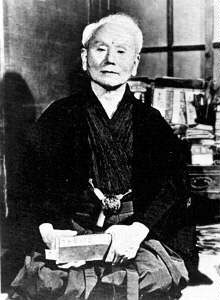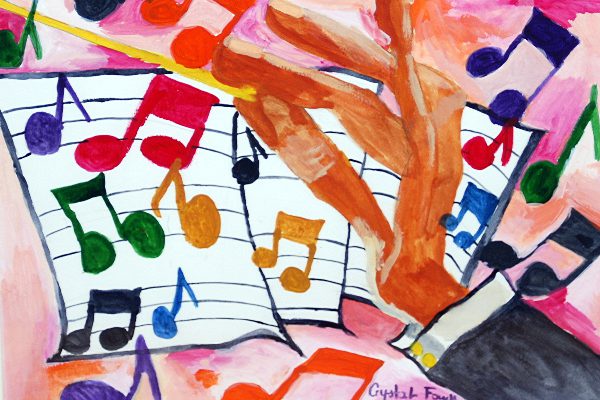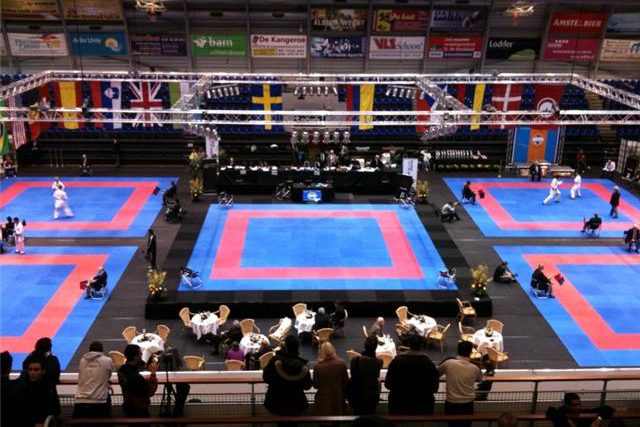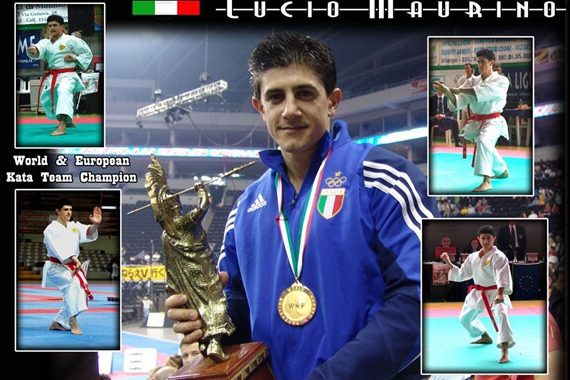Mabuni’s influence on JKA Shôtôkan-ryû
Another quite important aspect, often overlooked, is Mabuni’s strong influence on Funakoshi Gichin and the development of the Shôtôkan-style.
Funakoshi and Mabuni already knew each other from their time in the ‘Karate Kenkyûkai’ on Okinawa and always kept in close contact. Back in Okinawa Funakoshi had two main teachers: The minister of state Asato Ankô (1827-1906) and Mabuni’s later teacher Itosu Ankô. Although Funakoshi considered Asato as his most important teacher, Itosu taught him, by his own account “the Heian, Tekki and other Kata“.
But especially in view of the five Pinan (Heian) Kata, this direct line of transformation in between Itosu and Funakoshi is not as definite as it might appear on the first view. There are some hints indicating that Funakoshi did not learn the Pinan directly from Itosu, but rather from his student Mabuni. We know that Funakoshi started his Karate-training during primary school (in between 8 and 10 years of age) and that he studied for the next ten years (up to 1888, Meiji 21) with Asato and Itosu.
Most likely Itosu had developed the Pinan-forms by himself, on basis of Passai, Kôshokun, Useishi, Chintô and Chintê, and published them for the first time in spring of 1904 (Meiji 37), quite some time after Funakoshi had trained with him. Gima Makoto (1896-1989), a direct student of both Itosu, Yabu Kentsu (1866-1937) and Funakoshi states that Funakoshi just learned the Pinan right before his departure to Tôkyô (1922, Taishô 11).
Opposing this is a statement by Nagamine Shôshin (1907-1997), the founder of Matsubayashi-ryû, that Funakoshi had already taught them to Okinawan school children in 1916 (Taishô 5). The renowned Japanese Karate historian Dr. Fujiwara Ryôzo however says explicitly that Funakoshi learned the Pinan from Mabuni Kenwa in 1919 (Taishô 8).
 On basis of the available facts, the transfer of the Pinan/Heian-forms can’t be clearly traced back to one of those two lines of transmission (directly vs. indirectly via Mabuni).
On basis of the available facts, the transfer of the Pinan/Heian-forms can’t be clearly traced back to one of those two lines of transmission (directly vs. indirectly via Mabuni).
Against a direct transmission speaks the fact that just Funakoshi’s own statement dates a performance of the Pinan by Funakoshi before Itosu’s death (1915, Taishô 4). For a direct transmission on the other hand, speaks the huge period of time of over one decade (1904-1915) in between Itosu’s first publication of the Pinan and his passing. In view of that you also have to consider that Okinawa’s Karate-scene was rather clear and manageable in those days. In the humble opinion of the author that a hybrid of those theories, for instance a brief instruction by Itosu and a later adjustment and deepening by Mabuni, appears most likely.
A similar conclusion can be drawn from the statement that in 1928 (Shôwa 3) Mabuni corrected the Pinan-forms Ôtsuka had been taught by Funakoshi.
After his relocation to the Japanese mainland, Funakoshi Gichin himself considered 15 traditional Kata to be enough for the propagation of his idea of Karate. He explains those ‘big 15’ both in his first publications ’Ryûkyû Kenpô Karate’ (1922, Taishô 11) and ’Rentan Goshin Karate-jutsu’ (1925, Taishô 14), as well as in the two editions of his ’Mastertext’ (Karate-Do Kyôhan) from 1935 (Shôwa 10) and 1958 (Shôwa 33).
In his work ‘Karate-Dô Nyumon’ (Introduction to the Empty Hand) from 1943 (Shôwa 18) Funakoshi however writes that furthermore the forms Ten no Kata, Chi no Kata, Hito no Kata, Rôhai (Meikyô), Sôchin (Hakkô), Unsû (Hatsûn/Kiun), Shôtô, Chintê (Shôin), Gojûshihô/Usêshi (Hotaku) and Jiin (Shôkyo), have been “studied and investigated” in his Dôjô (Shôtôkan). While Shôtô, Ten, Chi and Hito no Kata are Funakoshi’s self-creations, we do not exactly know via what line of transmission Kata like Rôhai, Unsû, Chintê, Sôchin, Gojûshihô and Jiin come from.
Funakoshi’s students Nakayama Masatoshi (1913-1987), Nishiyama Hidetaka (1928-2008) and Obata Isao (1904-1976) founded the ‘Nihon Karate Kyôkai’ (JKA, Japan Karate Association) in May 1949 (Shôwa 24) and with that, no doubt, laid the headstone of the worldwide spread of both their ‘Shôtôkan’-concept and of Karate in general.
Shortly after the foundation, they added next to the aforementioned Kata, the forms Passai (Bassai) Shô, Kôshokun (Kanku) Shô, Gojûshihô Shô, Niseishi (Nijûshihô) and Wankan (Hito) to their curriculum. Similar to Rôhai, Unsû, Chintê, Sôchin, Gojûshihô and Jiin, we do not know from which teacher(s) these derived.
No official publication of the JKA (Japan Karate Association) or their derivatives makes any precise statements about how these additional ten Kata got into the style. It is quite apparent, that (at least by the name) they are all Kata that Mabuni was also teaching in his Shitô-Ryû at this time.
In view of Mabuni’s immense reputation, it is also no surprise to see that there was a lot of exchange between Mabuni and Funakoshi’s school. Mabuni’s son Kenei e.g. reports that Funakoshi himself should have send his third son Gigô (1906-1945) back from Japan to Okinawa in order to learn Kata from Mabuni. Right after Mabuni’s arrival in Tôkyô in 1928 (Shôwa 3), he evidently taught several of Funakoshi’s top-students, like Obata Isao and Konishi Yasuhiro. Even Funakoshi himself should have joined his students in training-sessions with Mabuni, especially as he advised them to study new Kata.

Mabuni’s son Kenzo remembers that in 1945 (Shôwa 20), Funakoshi Gichin sent his students Nakayama Masatoshi and Obata Isao to Ôsaka in order to train with Mabuni.
Short time after that, Funakoshi should have introduced Shôtôkan versions of the Unsû, Nijûshihô, and Gojûshihô Kata. This is probably the same visit Nakayama Masatoshi talk about, when he says: “Master Funakoshi never stopped to study other forms of Karate. When we visited master Mabuni, he told me to learn the Gojûshihô- and Nijûshihô-Kata, so that we could address them more intensively later on. Right after that, Mabuni Kenwa taught me these Kata.”.
Another senior student of Funakoshi and founder of Wado-Ryu, Ôtsuka Hironori, remembers that many of Funakoshi’s Kata came directly from Mabuni or were at least corrected by him.
When you compare the Shôtôkan- and the Shitô-versions of Kata like Unsû, Gojûshihô Dai/Shô, Jiin, Kôshokun Shô, Bassai Sho, Chintê and Niseishi it is quite striking that they basically just vary in view of some Shôtôkan-specific adjustments. [Jesse’s note: Like kiba-dachi instead of shikô-dachi, kôkutsu-dachi instead of nekoashi-dachi, yoko-geri instead of mae-geri, tate-shutô-uke instead of kake-shutô-uke etc. Or the constant execution of manji-uke in kôkutsu-dachi instead of zenkutsu/sôkutsu/nekoashi-dachi and so on.]. A close relationship is thus quite evident, which suggests a strong influence by Mabuni.
In consideration of these facts, we can say without doubt that the JKA Shôtôkan has been heavily influenced by the founder of Shitô-ryû, Mabuni. At least half out of the 26 Kata in Shôtôkan came directly from Mabuni or have been corrected by him.
Mabuni Kenwa was thus much more important for the development and shape of the style of Shôtôkan, than it is today usually assumed or acknowledged by their representatives.
Mabuni Kenwa was without doubt an outstanding Karateka. His research and work still highly affects the world’s Karate scene. Next to his two sons and successors Kenei and Kenzo, Mabuni Kenwa had a huge amount of important students. Over the years, most of them founded their own styles and organisations. Mabuni’s Shitô-ryu is today one of the biggest Karate styles, with Dôjô and branches all over the world.
Mabuni Kenwa died at the 23rd of May 1952 (Shôwa 27) at the age of 62 years.
“Those people who are truly thinking of the future of Karate
should not keep a closed mind and limit themselves
to learning only an empty shell,
but should strive to study the complete art.”
– Mabuni Kenwa
Acknowledgements:
The author would like to thank Mr. George Kohler (Melissa, Texas) and especially Mr. Mark Tankosich, MA (Hiroshima University of Economics) for their kind and patient help in the allocation and interpretation of some of the Japanese sources. Furthermore the author would like to thank Mr. Craig Roberts, BC (Sydney, Australia) for his help with proof-reading and copy-editing.
Bibliography:
Abernethy, Iain (2006): Interview with Hanshi Haruyoshi Yamada, 9th Dan, May 2nd 2006 (http://www.iainabernethy.com/cgi-bin/ultimatebb.cgi?ubb=get_topic;f=12;t=000019)
Aston, W. G. (trans.) (1998): Nihongi: Chronicles of Japan from the Earliest Times to 697 A.D., Rutland 111998.
Bishop, Mark (1999): Okinawan Karate: Teachers, Styles and Secret Techniques, Rutland 21999.
Bittmann, Heiko (2000): Karate-Do: Der Weg der Leeren Hand; Meister der vier großen Schulrichtungen und ihre Lehre (Karate-Do: The Way of the Empty Hand; Masters of the Four Big Styles and their Teaching), Ludwigsburg 22000.
Chambers, Damian (n.d.): Kenwa Mabuni: The Founder of Shotokan? (http://www.shitokai.com/pdf/mabuni.pdf)
Ettig, Wolfgang (2004): Takamatsu Toshitsugu – Die Biographie einer Kampfkunstlegende (Takamatsu Toshitsugu – The Biography of a Martial Arts Legend), Schmitten/Ts. 2004.
Fraguas, Jose M. (2001): Karate Masters, Burbank, 2001.
Funakoshi, Gichin (1958/1973): Karate-Do Kyohan: The Master Text, (Jap. original edition published in 1958), Tokyo 1973.
Funakoshi, Gichin (1943/1988): Karate-Do Nyumon, (Jap. original edition published in 1943), Tokyo 1988.
Funakoshi, Gichin (1975/1993): Karate-Do: Mein Weg (Karate-Do: My Way of Life), (Jap. original edition written in 1956, published in 1975), Heidelberg-Leimen 1993.
Golinski, Matthias (2004): Legenden des Karate: Konishi Yasuhiro und das Shindo Jinen-Ryu (Legend of Karate: Konishi Yasuhiro and the Shindo Jinen-Ryu), 15. August 2004, (http://www.tsuru.de/geschichte/konishi/konishi.htm).
Golinski, Matthias (2005): Das Bubishi – Eine Einleitung zur „Bibel des Karate“ (The Bubishi – An Introduction to the „Bible of Karate“), 15. April 2005, (http://www.tsuru.de/geschichte/bubishi/bubishi.htm).
Golinski, Matthias (2007): Legenden des Ryukyu Kobudo: Über das Leben und Wirken des Taira Shinken (Legends of Ryukyu Kobudo: About the Life and Work of Taira Shinken), 15. September 2007 (http://www.tsuru.de/geschichte/taira/taira.htm).
Hassel, Randall G. (1997): Gespräche mit dem Meister – Nakayama Masatoshi (Conversations with the Master – Nakayama Masatoshi), Lauda Königshofen 1997.
Hevener, Phillip T. (2008): Fujita Seiko – The Last Koga Ninja, Philadelphia 2008.
High, Howard P. (2006): The History of Japan Karate-Do Ryobu-Kai, 06. Oktober 2006 (http://jkr.com/index.php?option=com_content&task=view&id=14&Itemid=27).
Hokama, Tetsuhiro (2005): 100 Masters of Okinawan Karate, self-published, Nishihara 2005.
Kaminaga, Shigemi (1996): Ko Ueno Takashi Sensei Niju Shuki Tsuito – Nihon Dento Bujutsu Enbu Taikai (The Late Ueno Takashi Sensei 20th Anniversary Memorial – Traditional Japanese Martial Arts Demonstration Meeting), Tokyo 1996.
Mabuni, Kenei (2001): Leere Hand – Vom Wesen des Budo-Karate (Empty Hand – About the Essence of Budo-Karate), Chemnitz 2007.
Mabuni, Kenwa (1934a): Kata wa Tadashiku Renshu Seyo (Practice the Form Correctly), in: Nakasone, Genwa, Karate-Kenkyu (Research on the Empty Hand), Tokyo 1934 (Reprint 2003), p. 15.
Mabuni, Kenwa (1934b): Kumite no Kenkyu (Kumite Research), in: Nakasone, Genwa, Karate-Kenkyu (Research on the Empty Hand), Tokyo 1934 (Reprint 2003), p. 28-29.
Mabuni, Kenwa (1938): Aragaki Sochin, in: Nakasone, Genwa (ed.), Karate-Do Taikan (Overview on the Way of the Empty Hand), Tokyo 1938 (Reprint 1991), p. 143-180.
Mabuni, Kenwa/ McKenna, Mario (trans.) (1934/2002): Kobo Jizai Goshinjutsu Karate Kenpo – The Free Self-defense Art of Karate Kenpo, (Jap. original edition published in 1934), (www.mariomckenna.com) 2002.
Mabuni, Kenwa/ McKenna, Mario (trans.) (1934/2003): Sêpai no Kenkyu’ – The Study of Seipai, (Jap. original edition published in 1934), (www.mariomckenna.com) 2003.
Mabuni, Kenwa/ Nakasone, Genwa (1938/2000): Haltung des Herzens des Übenden auf dem Wege der Leeren Hand (1938) (Position of the Heart of the Practicioner on the Way of the Empty Hand), in: Bittmann, Heiko: Karate-Do: Der Weg der Leeren Hand; Meister der vier großen Schulrichtungen und ihre Lehre (Karate-Do: The Way of the Empty Hand; Masters of the Four Big Styles and their Teaching), Ludwigsburg 22000, p. 169-187.
Mabuni, Kenwa/ Nakasone, Genwa (1938): Karate-Do Nyumon. Betsumei: Karatejutsu Kyohan (Introduction to the Way of the Empty Hand. Section Name: Teaching Method of the Art of the Empty Hand), Tokyo 1938.
Mabuni, Kenwa/ Tankosich, Mark (trans.): Practice Kata Correctly, (http://seinenkai.com/articles/tankosich/tankosich3.html)
McCarthy, Patrick (1989): Chronology (http://www.koryu-uchinadi.com/irkrs/Chronology_Informal.htm).
McCarthy, Patrick (1997): The Bible of Karate: Bubishi, Rutland 41997.
McCarthy, Patrick (1999): Standing on the Shoulders of Giants: The Mabuni Kenwa Story, in: McCarthy, Patrick, Ancient Okinawan Martial Arts, Vol. 2, North Clarendon 1999, p. 1-37.
Mol, Serge (2001): Classical Fighting Arts of Japan – A complete Guide to Koryu Jujutsu, Tokyo 2001.
Moledzki, Sam (n.d., a): Iwata Manzo (http://www.shitoryu.org/bios/iwata/iwata.htm).
Moledzki, Sam (n.d., b): The Shito-Ryu Karate-Do of Kenwa Mabuni (http://www.shitoryu.org/bios/mabuni/mabuni.htm).
Miyagi, Chojun (1934/2000): Allgemeine Darstellung zum Weg der Chinesischen Hand (1934) (General Outline on the Way of the Chinese Hand), in: Bittmann, Heiko, Karate-Do: Der Weg der Leeren Hand; Meister der vier großen Schulrichtungen und ihre Lehre (Karate-Do: The Way of the Empty Hand; Masters of the Four Big Styles and their Teaching), Ludwigsburg 22000, p. 150-168.
Nagamine, Shoshin/ McCarthy, Patrick (trans.) (2000): Tales of Okinawa’s Great Masters, Rutland 2000.
Noble, Graham (2006a): Master Funakoshi’s Karate: The History and Development of the Empty Hand Art. (Pt. 1), (http://seinenkai.com/articles/noble/noble-funakoshi1.html).
Noble, Graham (2006b): Master Funakoshi’s Karate: The History and Development of the Empty Hand Art. (Pt. 2), 28 Feb. 2006 (http://seinenkai.com/articles/noble/noble-funakoshi2.html).
Noble, Graham/ McLaren, Ian/ Karasawa, N. (1988): Masters of the Shorin-Ryu – Part One, in: Fightings Arts International, Issue No. 50, Volume 9, No. 2, 1988, p. 24-28. (http://seinenkai.com/articles/noble/noble-shorin1.html)
Sells, John (n.d.): Shito-Ryu History (http://www.martialsource.com/shitohistory.htm).
Swift, Joe (n.d.): Wisdom from the Past: Tidbits on Kata Applications from Pre-War Karate Bookp. Part One (http://www.seinenkai.com/articles/swift/swift-tidbits1.html).
Tokitsu, Kenji (1984): Réflexion historique sur le karate 5: Les kata et le combat (Historical Reflection on Karate 5: Kata and combat), 1984 (http://www.tokitsu.com/ca/presentation/articles/fr/reflexion-historique-sur-le-karate-5/karate-kata-otsuka-funakoshi-kano-demonstration-de-combat-budo-historique.html).
Tokitsu, Kenji (1988): L’historie du karatè 2: La transformation des kata classiques (The History of Karate 2: The Transformation of the classical Kata), 1988 (http://www.tokitsu.com/fr/presentation/articles/fr/lhistoire-du-karate-2/transformation-modification-evolution-des-kata-pinan-et-naifanchi-par-itosu.html).
Watatani, Kiyoshi/ Yamada, Tadashi (ed.) (1978): Bugei Ryuha Daijiten (Big Encyclopaedia of the Martial Arts Schools), Tokyo 1978.
Wittwer, Henning (2007): Shotokan: Überlieferte Texte – historische Untersuchungen (Shotokan: Traditional Texts, Historical Analysis), Niesky 2007.



6 Comments